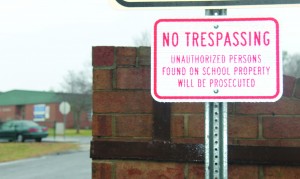By Caroline Schneider
Editor-in-Chief
“I do [feel safe at Northwood], and I feel like if I didn’t feel safe, my concerns would be addressed,” said English teacher Meredith Lewis. “And that’s really important.”
After last month’s North Carolina college gunmen incidents, where three NC college campuses, including East Carolina University, had to go into a lock down, and October’s Cape Fear High School shooting, it’s safe to say that students and teachers alike are thinking about what ways they’re being protected at Northwood.
“I feel like Pittsboro is a really safe location, and we don’t have to worry about gangs at Northwood because we don’t have any [prominent activity],” said student body president, Diane Thompson.
And gang violence at Cape Fear may have been the cause of the shooting in October.
English teacher Nick Winstead used to teach at a school in Durham, and he has noticed differences between the environment in Pittsboro compared to the environment in Durham, and how that affects a school’s safety.
“There are a lot of places in Durham where I think it’s easier to find elements that can tempt people to do something wrong, versus here, where it’s sort of more isolated,” Winstead said. “I feel like in Pittsboro, it’s harder to get mixed up in things that could distract you from what school is for.”
Northwood’s School Resource Officer, Herbie Stubbs, agrees that Northwood’s location has a large impact on the ways the school keeps students safe, but his views are more focused on how the campus is set up, rather than that the school is in Pittsboro.
“Our school location does help out: there’s only one way in, one way out,” Stubbs said.
But it’s much more than location that helps keep Northwood secure. From “Code Blue” drills to locking doors, with the help of security cameras and an SRO, Northwood does a lot to protect the students within the school.
“Being proactive keeps schools safe,” said Stubbs. “[We are] proactive on discipline, maybe a little harder than some schools are, so students know, ‘Hey, I’m not going to do this or do that because of the consequences behind it.’”
Lewis agrees that the way discipline is handled has an impact on fights at Northwood, and since Principal Chris Blice arrived in 2009, the number of fights the school has per year has decreased, with only one fight last year.
“I feel like [Blice] encourages good behavior, so bad behavior, whether it’s dangerous or threatening, is just not acceptable,” Lewis said.
Another way that Northwood keeps its students safe is that Blice has reinforced the idea of keeping teachers and administrators visible at all time. Teachers stand in the hallways during class changes, and administrators and Stubbs walk around the campus throughout the day.
“I’m pretty mobile,” said Stubbs. “I don’t sit in my office a whole lot, so [I’m] able to see what’s going on and what’s out of place.”
And although the faculty and staff do what they can to keep the school as secure as possible, Blice feels that the students also have a big part in keeping the school out of harm’s way.
“The best measure is really [the students] being conscious, and hopefully we’ve established the kind of relationships with [them] that if [they] had a concern, if something was happening that wasn’t safe, [they would] come and talk to us about it, and we would take it very seriously,” said Blice. “That’s the thing that we learned from [the Columbine incident], was to take [students] seriously, listen to them.”
And Blice practices listening to students in how he trains his teachers. Lewis says that when it comes to school safety, one of the most important things the administration has trained her to do is be conscious of what’s going on with the students in her class.
“A lot of what we’re encouraged to do is look out for changes in behavior and report it if something seems really fishy, because it’s our job to keep [students] safe as well,” Lewis said.
“Code Blue” drills are the most prominent ways that Northwood acts to keep students protected.
The practice involves students getting on the floor as to not be visible if there were a gunman on campus. Teachers lock the doors and close the blinds and everyone is to remain quiet until they hear it is safe. “Code Blue” drills happen once a year, with the most recent one being first semester of last year, but not all students feel that is enough.
“Say we have a Code Blue practice in first period but something happened in third period, we wouldn’t know [what to do],” Thompson said. “And I think that they’re not handled very well.”
Blice doesn’t completely disagree.
“Honestly, the hardest part of that is getting students to cooperate, and that should be the easiest part,” Blice said. “Safety is something that we’re all responsible for.”
Lewis finds that students have trouble cooperating because they know “Code Blue” is a drill.
“It’s always hard because there’s this level of unreality about it where it’s hard to take something seriously when it doesn’t seem like it could happen,” said Lewis. “But just having a plan in place is what’s important, whether or not the practices are perfect.”
Despite the imperfect drills, however, the number of safety precautions Northwood takes have so far been pretty effective.
“We have a good, safe school,” said Stubbs. “Keep it that way.”

